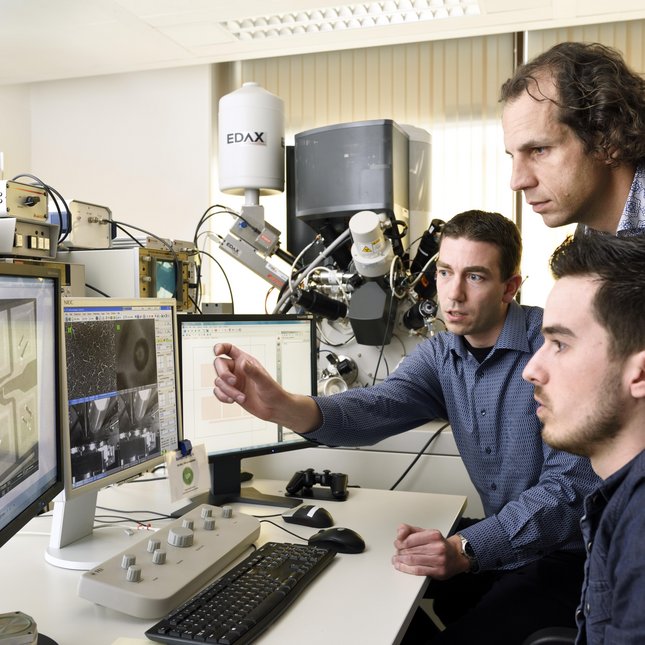
It is expected that future nanoelectronics will rely on 1D and 2D nanomaterials in order to continue the scaling as described by Moores law. This will require advanced processing techniques to integrate these nanomaterials into devices.
ALD on 1D and 2D nanomaterialsFor the successful introduction of nanomaterials such as nanowires, nanotubes, graphene and other 2D materials in future nanoelectronics, the ability to deposit high quality metal contacts and dielectrics on these nanomaterials is required. Conventionally, such contacts and dielectrics are deposited using physical vapor deposition techniques. However, the layers created this way have significant limitations in terms of processing capabilities and in terms of layer quality. Alternatives need therefore to be explored for proper future device performance.
Within the group Plasma & Materials Processing (PMP), we therefore investigate the viability of atomic layer deposition (ALD) for the creation of metal contacts and dielectrics on graphene. The growth of ALD layers on graphene is inherently difficult due to the absence of surface groups and the hydrophobicity of the surface. Therefore, ALD tends to start preferentially on defect sites like grain boundaries, wrinkles, etc. present in graphene. We circumvent this undesirable nucleation behaviour on graphene by surface modifications. This leads to improved uniform layer growth. In addition, we also study the nucleation behaviour with advanced in-situ spectroscopy.
NanopatterningThe PMP group also investigates and develops novel patterning methods based on bottom-up processing. One method that has been developed is the so-called direct-write ALD technique. This method exploits the area-selectivity of certain ALD processes to deposit patterns of materials such as platinum.We use this method to contact nanomaterials such as carbon nanotubes and graphene in order to form transistors and other devices for future nanoelectronics. These delicate materials are very sensitive to processing issues during conventional top-down lithography (such as the use of resist films) which degrade their quality. Being a bottom-up approach, the direct-write ALD technique circumvents many of these problems.
The direct-write ALD technique consists of two processing steps carried out sequentially. First, an ultra-thin ‘seed layer’ (consisting of platinum nanoparticles embedded in carbon) is directly deposited in the desired pattern via electron beam induced deposition (EBID). Next, an area-selective platinum ALD process is employed which is modified in such a way that the growth can only start on the seed layers due to the presence of the catalytically active platinum particles, but not on the surrounding substrate. This step purifies the seed layers and builds them into pure platinum structures.
It is expected that future nanoelectronics will rely on 1D and 2D nanomaterials in order to continue the scaling as described by Moores law. This will require advanced processing techniques to integrate these nanomaterials into devices.
ALD on 1D and 2D nanomaterialsFor the successful introduction of nanomaterials such as nanowires, nanotubes, graphene and other 2D materials in future nanoelectronics, the ability to deposit high quality metal contacts and dielectrics on these nanomaterials is required. Conventionally, such contacts and dielectrics are deposited using physical vapor deposition techniques. However, the layers created this way have significant limitations in terms of processing capabilities and in terms of layer quality. Alternatives need therefore to be explored for proper future device performance.
Within the group Plasma & Materials Processing (PMP), we therefore investigate the viability of atomic layer deposition (ALD) for the creation of metal contacts and dielectrics on graphene. The growth of ALD layers on graphene is inherently difficult due to the absence of surface groups and the hydrophobicity of the surface. Therefore, ALD tends to start preferentially on defect sites like grain boundaries, wrinkles, etc. present in graphene. We circumvent this undesirable nucleation behaviour on graphene by surface modifications. This leads to improved uniform layer growth. In addition, we also study the nucleation behaviour with advanced in-situ spectroscopy.
NanopatterningThe PMP group also investigates and develops novel patterning methods based on bottom-up processing. One method that has been developed is the so-called direct-write ALD technique. This method exploits the area-selectivity of certain ALD processes to deposit patterns of materials such as platinum.We use this method to contact nanomaterials such as carbon nanotubes and graphene in order to form transistors and other devices for future nanoelectronics. These delicate materials are very sensitive to processing issues during conventional top-down lithography (such as the use of resist films) which degrade their quality. Being a bottom-up approach, the direct-write ALD technique circumvents many of these problems.
The direct-write ALD technique consists of two processing steps carried out sequentially. First, an ultra-thin ‘seed layer’ (consisting of platinum nanoparticles embedded in carbon) is directly deposited in the desired pattern via electron beam induced deposition (EBID). Next, an area-selective platinum ALD process is employed which is modified in such a way that the growth can only start on the seed layers due to the presence of the catalytically active platinum particles, but not on the surrounding substrate. This step purifies the seed layers and builds them into pure platinum structures.
